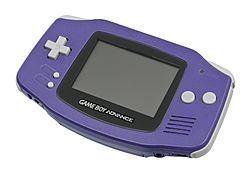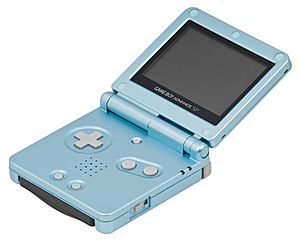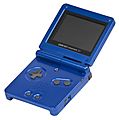Game Boy Advance facts for kids

The indigo version of the original Game Boy Advance.
|
|
| Developer | Nintendo R&E |
|---|---|
| Manufacturer | Nintendo |
| Product family | Game Boy line |
| Type | Handheld game console |
| Generation | Sixth generation |
| Release date | Game Boy Advance:
AGS-001:
|
| Retail availability | 2001–2010 |
| Discontinued |
|
| Units sold | 81.51 million (as of June 30, 2010[update]) |
| Media | ROM cartridge |
| Power | 2 × AA batteries |
| CPU | ARM7TDMI @ 16.78 MHz, Zilog Z80 @ 8 or 4 MHz |
| Memory | 32 KB internal, 256 KB external, 96 KB VRAM |
| Display | TFT LCD, 240×160 pixels, 40.8×61.2 mm |
| Best-selling game | Pokémon Ruby and Sapphire, 16 million combined |
| Backward compatibility |
Game Boy Game Boy Color |
| Predecessor | Game Boy Color (1998) |
| Successor | Nintendo DS (2004-2014) |
The Game Boy Advance, often called the GBA, is a cool handheld video game system. It was made by Nintendo, a famous company that makes many video games. The GBA was a big step up from its older brothers, the Game Boy and Game Boy Color. Later, it was followed by the Nintendo DS.
The Game Boy Advance first came out in Japan on March 21, 2001. After that, it was released in North America on June 11, 2001. Gamers in Australia got it on June 20, 2001, and in Europe on June 22, 2001.
Contents
Different Game Boy Advance Models
The Game Boy Advance family includes a few different versions. Each one brought new features or a different design. Let's explore them!
Game Boy Advance SP: The Foldable One
The Game Boy Advance SP was announced in 2002. It was the first new version of the GBA. It came out in Japan on February 14, 2003, and in other places like Europe and North America soon after.
The SP is special because it has a "clamshell" design. This means it can fold in half, protecting the screen when you're not playing. It also has a rechargeable battery, so you don't need to buy AA batteries. Plus, it has a bright, backlit screen, which made playing in the dark much easier! Like the original GBA, you could play both Game Boy and Game Boy Color games on it.
Game Boy Micro: The Tiny One

The Game Boy Micro was the last model in the Game Boy series. It was announced in 2005. This tiny console was designed to fit into small pockets. It kept the rechargeable battery and backlit screen from the Game Boy Advance SP.
However, to make it so small, some things were changed. The Game Boy Micro could not play original Game Boy or Game Boy Color games. It also didn't work with some accessories made for the GBA and SP. The Micro had cool removable face plates, so you could change its look. Even though it was neat, it didn't sell very well because the Nintendo DS had already come out and could also play GBA games.
Micro's Cool Features
- Size: It was super small, about 50×101×17.2 mm (2×4×0.7 inches).
- Weight: It weighed only 80 grams (2.8 ounces).
- Screen: It had a 51 mm (2-inch) screen with adjustable brightness.
- Battery: A built-in rechargeable battery gave you up to eight hours of playtime.
- Headphones: It had a standard headphone jack for your earbuds.
The Game Boy Micro also had a switch on the side to change the volume. If you pressed the L shoulder button, you could adjust the screen's brightness to five different levels.
Images for kids
-
Clockwise from left: A Game Boy Game Pak, a Game Boy Advance Game Pak, and a Nintendo DS Game Card. On the far right is a US nickel shown for scale.
See also
 In Spanish: Game Boy Advance para niños
In Spanish: Game Boy Advance para niños









